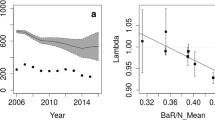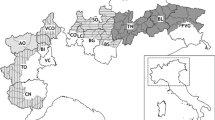Abstract
In a previous study, we suggested that hyperpredation by shared predators on red-legged partridges (Alectoris rufa), once a parasite (rabbit haemorrhagic disease, RHD) had decimated populations of rabbit (Oryctolagus cuniculus), the primary prey for most of the Mediterranean predators, was a major force driving partridge population dynamics in Spain years ago (Moleón et al., PLoS One 3:e2307, 2008). Recently, however, Blanco-Aguiar et al. (Eur J Wildl Res 58:433–439, 2012) have asserted that this conclusion is poorly evidence-based and can subsequently promote raptor persecution by hunters. In response to Blanco-Aguiar and colleagues, here we provide complementary insights that favour our earlier hypothesis. After explaining several key concepts of the hyperpredation process, we use additional data and analyses to show that (1) a synchronised regime shift (i.e. a step, abrupt change in population size) to significantly lower population levels in both the rabbit and partridge populations took place coinciding with the RHD outbreak; (2) rabbit and partridge population dynamics were highly synchronised after the RHD outbreak, but not before; (3) an enhanced spatial autocorrelation at all the spatial scales emerged after RHD for partridge populations; and (4) the main shared predators’ diet patterns were consistent with the hypothesis of enhanced predation pressure as a plausible mechanism behind the observed partridge dynamics. We support the idea that hunting bag data may be useful to infer realistic population dynamics and the ecological mechanisms explaining them, provided that (1) they are corrected by the number of hunting licenses; (2) appropriate statistical tools are employed; and (3) methodological constraints are adequately taken into account. Finally, we argue that the opinion of Blanco-Aguiar and colleagues that our original results can lead to raptor persecution is a misinterpretation of our study. In this sense, we make an appeal for the importance of accurately differentiating between the ultimate (e.g. infectious diseases favoured by humans) and the proximate (e.g. enhanced predation pressure) causes of the decline in prey of economic interest (e.g. game species) in order to avoid unnecessary, unfounded or presumed conflicts with lobbies of conservation concern (e.g. hunters).




Similar content being viewed by others
References
Bate AM, Hilker FM (2012) Rabbits protecting birds: hypopredation and limitations of hyperpredation. J Theor Biol 297:103–115
Blanco-Aguiar JA, Virgós E, Villafuerte R (2004) Perdiz roja, Alectoris rufa. In: Madroño A, González C, Atienza JC (eds) Libro Rojo de las Aves de España. Dirección General para la Biodiversidad-SEO/BirdLife, Madrid, pp 182–185
Blanco-Aguiar JA, Delibes-Mateos M, Arroyo B, Ferreras P, Casas F, Real R, Vargas JM, Villafuerte R, Viñuela J (2012) Is the interaction between rabbit hemorrhagic disease and hyperpredation by raptors a major cause of the red-legged partridge decline in Spain? Eur J Wildl Res 58:433–439
Buenestado FJ, Ferreras P, Delibes-Mateos M, Tortosa FS, Blanco-Aguiar JA, Villafuerte R (2008) Habitat selection and home range size of red-legged partridges in Spain. Agric Ecosyst Environ 126:158–162
Calvete C, Estrada R (2004) Short-term survival and dispersal of translocated European wild rabbits. Improving the release protocol. Biol Conserv 120:507–516
Calvete C, Estrada R, Villafuerte R, Osácar JJ, Lucientes J (2002) Epidemiology of viral hemorrhagic disease (VHD) and myxomatosis in the wild rabbit (Oryctolagus cuniculus) in the mid-Ebro valley, Spain. Vet Rec 150:776–782
Calvete C, Villafuerte R, Lucientes J, Osácar JJ (2004) Effectiveness of traditional wild rabbit restocking in Spain. J Zool 241:271–277
Calvete C, Calvo JH, Sarto P, Gaitán I (2012) Detectada una nueva cepa viral de la enfermedad hemorrágica del conejo. Quercus 322:30–35
Carrascal LM (2011) Data, preconceived notions and methods: the case of population sizes of common breeding birds in Spain. Ardeola 58:371–385
Cattadori IM, Haydon DT, Thirgood SJ, Hudson PJ (2003) Are indirect measures of abundance a useful index of population density? The case of red grouse harvesting. Oikos 100:439–446
Ceballos O (1991) Repercusión de la Parvovirosis sobre las poblaciones del Conejo de campo Oryctolagus cuniculus en Navarra. Technical report. Servicio de Medio Ambiente, Gobierno de Navarra, Pamplona
Cleveland WS, Devlin SJ (1988) Locally-weighted regression: an approach to regression analysis by local fitting. J Am Stat Assoc 403:596–610
Courchamp F, Langlais M, Sugihara G (2000) Rabbits killing birds: modelling the hyperpredation process. J Anim Ecol 69:154–164
Dalton KP, Nicieza I, Balseiro A, Muguerza MA, Rosell JM, Casais R, Álvarez AL, Parra F (2012) Variant rabbit hemorrhagic disease virus in young rabbits, Spain. Emerg Infect Dis 18:2009–2012
Delibes-Mateos M, Ferreras P, Villafuerte R (2009) European rabbit population trends and associated factors: a review of the situation in the Iberian Peninsula. Mamm Rev 39:124–140
Donázar JA (1989) Variaciones geográficas y estacionales en la alimentación del Búho Real (Bubo bubo) en Navarra. Ardeola 36:25–39
Duarte J, Farfán MA, Vargas M (2011) New data on mortality, home range and dispersal of red-legged partridges (Alectoris rufa) released on a mountain range. Eur J Wildl Res 57:675–678
Fernández C (1993) Effect of te viral haemorrhagic pneumonia of the wild rabbit on the diet and breeding success of the Golden Eagle Aquila chrysaetos (L.). Rev Ecol - Terre Vie 48:323–329
Ferreira C, Paupério J, Alves PC (2010) The usefulness of field data and hunting statistics in the assessment of wild rabbit (Oryctolagus cuniculus) status in Portugal. Wildl Res 37:223–229
Gortázar C, Villafuerte R, Martín M (2000) Success of traditional restocking of red-legged partridge for hunting purposes in areas of low density of northeast Spain Aragón. Eur J Wildl Res 46:23–30
Liebhold A, Koenig WD, Bjornstad ON (2004) Spatial synchrony in population dynamics. Annu Rev Ecol Evol Syst 5:467–490
Lourenço R, Santos SM, Rabaça JE, Penteriani V (2011) Superpredation patterns in tour large European raptors. Popul Ecol 53:175–185
Mañosa S (1994) Goshawk diet in a Mediterranean area of northeastern Spain. J Raptor Res 28:84–92
Moleón M, Almaraz P, Sánchez-Zapata JA (2008) An emerging infectious disease triggering large-scale hyperpredation. PLoS One 3:e2307
Moleón M, Sánchez-Zapata JA, Real J, García-Charton JA, Gil-Sánchez JM, Palma L, Bautista J, Bayle P (2009) Large-scale spatio-temporal shifts in the diet of a predator mediated by an emerging infectious disease of its main prey. J Biogeogr 36:1502–1515
Moleón M, Sánchez-Zapata JA, Gil-Sánchez JM, Barea-Azcón JM, Ballesteros-Duperón E, Virgós E (2011) Laying the foundations for a human–predator conflict solution: assessing the impact of Bonelli’s eagle on rabbits and partridges. PLoS One 6:e22851
Moleón M, Sánchez-Zapata JA, Gil-Sánchez JM, Ballesteros-Duperón E, Barea-Azcón JM, Virgós E (2012) Predator–prey relationships in a Mediterranean vertebrate system: Bonelli’s eagles, rabbits and partridges. Oecologia 168:679–689
Murgui E (2011) How many common breeding birds are there in Spain? A comparison of census methods and national population size estimates. Ardeola 58:343–364
Norbury G (2001) Conserving dryland lizards by reducing predator-mediated apparent competition and direct competition with introduced rabbits. J Appl Ecol 38:1350–1361
Pérez JA, Alonso ME, Gaudioso VR, Olmedo JA, Díez C, Bartolomé D (2004) Use of radiotracking techniques to study a summer repopulation with red-legged partridge (Alectoris rufa) chicks. Poult Sci 83:882–888
Real J (1991) L’aliga perdiguera Hieraaetus fasciatus a Catalunya: status, ecologia trófica, biología reproductora i demografía. PhD thesis, Universitat de Barcelona, Barcelona
Rodionov SN (2004) A sequential algorithm for testing climate regime shifts. Geophys Res Lett 31:L09204. doi:10.1029/2004GL019448
SEO/BirdLife (2006) Monitoring common breeding birds in Spain. The SACRE Programme Report 1996–2005. SEO/BirdLife, Madrid
Serrano D (1998) Diferencias interhábitat en la alimentación del Búho Real (Bubo bubo) en el valle medio del Ebro (NE España): efecto de la disponibilidad de conejo (Oryctolagus cuniculus). Ardeola 45:47–53
Serrano D (2000) Relationship between raptors and rabbits in the diet of eagle owls in southwestern Europe: competition removal or food stress? J Raptor Res 34:305–310
Smith AP, Quin DG (1996) Patterns and causes of extinction and decline in Australian conilunire rodents. Biol Conserv 77:243–267
Tella JL, Mañosa S (1993) Eagle Owl predation on Egyptian Vultures and Northern Goshawk: possible effect of a decrease in European Rabbit availability. J Raptor Res 27:111–112
Thirgood SJ, Redpath SM (2008) Hen harriers and red grouse: science, politics and human–wildlife conflict. J Appl Ecol 45:1550–1554
Villafuerte R, Delibes-Mateos M (2007) Oryctolagus cuniculus (Linnaeus, 1758). In: Palomo LJ, Gisbert J, Blanco JC (eds) Atlas y Libro Rojo de los Mamíferos Terrestres de España. Dirección General para la Biodiversidad-SECEM-SECEMU, Madrid, pp 490–491
Villafuerte R, Calvete C, Blanco JC, Lucientes J (1995) Incidence of viral hemorrhagic disease in wild rabbit populations in Spain. Mammalia 59:651–659
Virgós E, Cabezas-Díaz S, Lozano J (2007) Is the wild rabbit (Oryctolagus cuniculus) a threatened species in Spain? Sociological constraints in the conservation of species. Biodivers Conserv 16:3489–3504
Acknowledgments
M. Moleón was supported by a postdoctoral grant from the Spanish Ministry of Education (Programa Nacional de Movilidad de Recursos Humanos del Plan Nacional de I+D+i 2008–2011). We thank V. Penteriani and one anonymous reviewer for helpful comments.
Author information
Authors and Affiliations
Corresponding author
Additional information
Communicated by C. Gortazar
Rights and permissions
About this article
Cite this article
Moleón, M., Almaraz, P. & Sánchez-Zapata, J.A. Inferring ecological mechanisms from hunting bag data in wildlife management: a reply to Blanco-Aguiar et al. (2012). Eur J Wildl Res 59, 599–608 (2013). https://doi.org/10.1007/s10344-013-0711-1
Received:
Revised:
Accepted:
Published:
Issue Date:
DOI: https://doi.org/10.1007/s10344-013-0711-1




